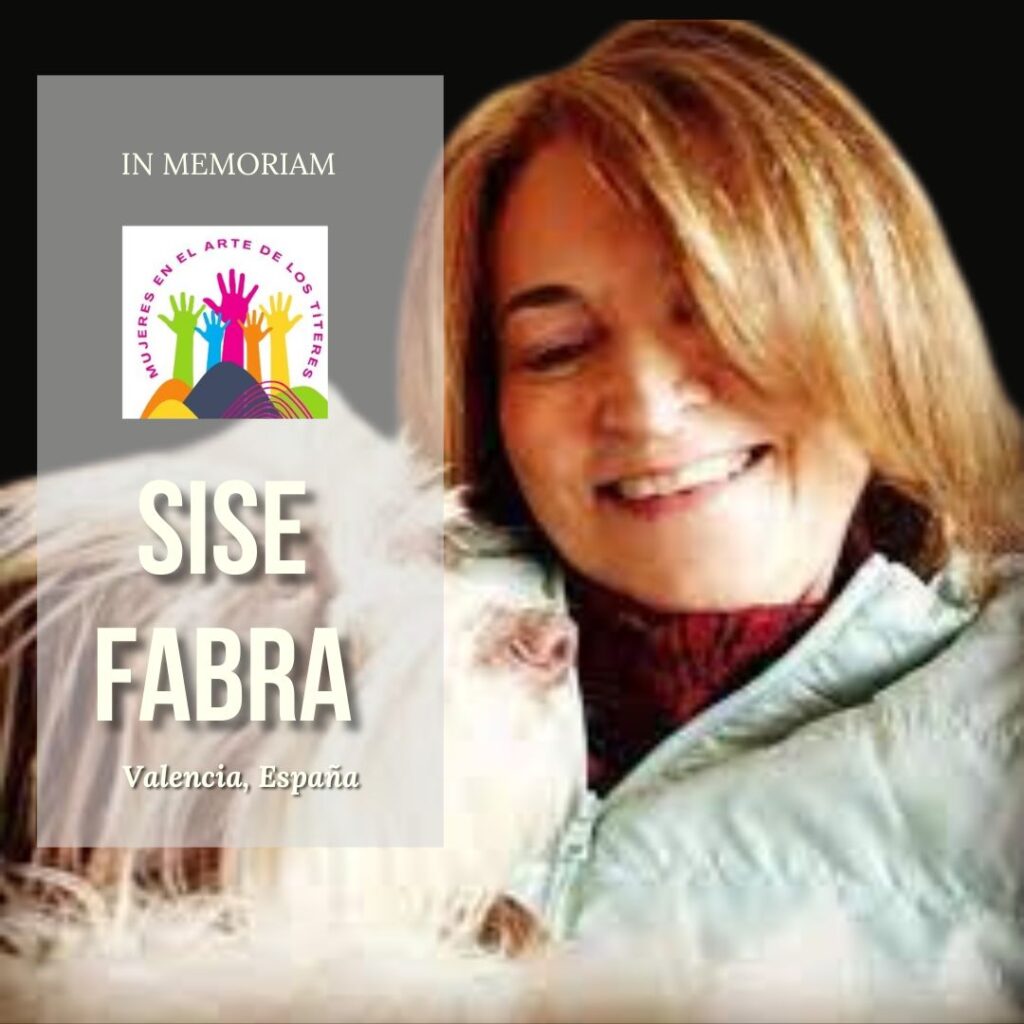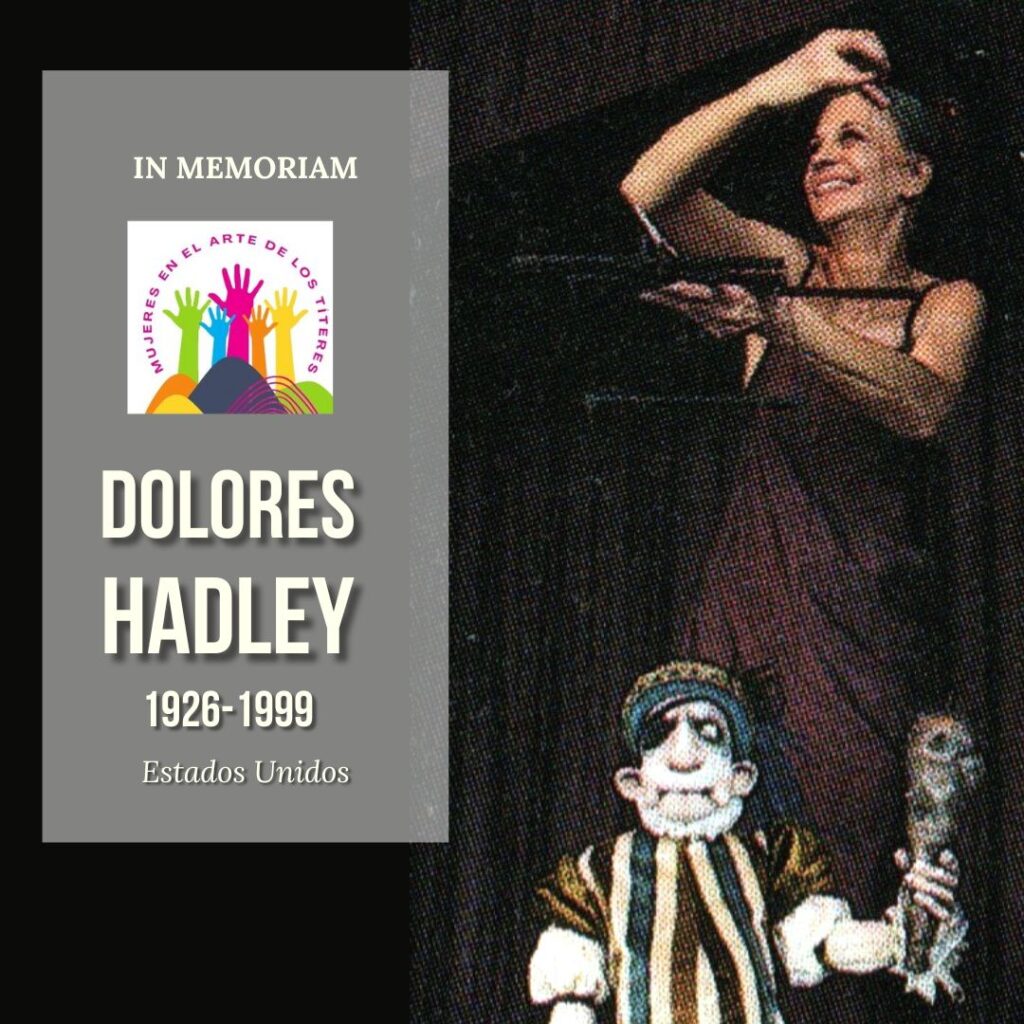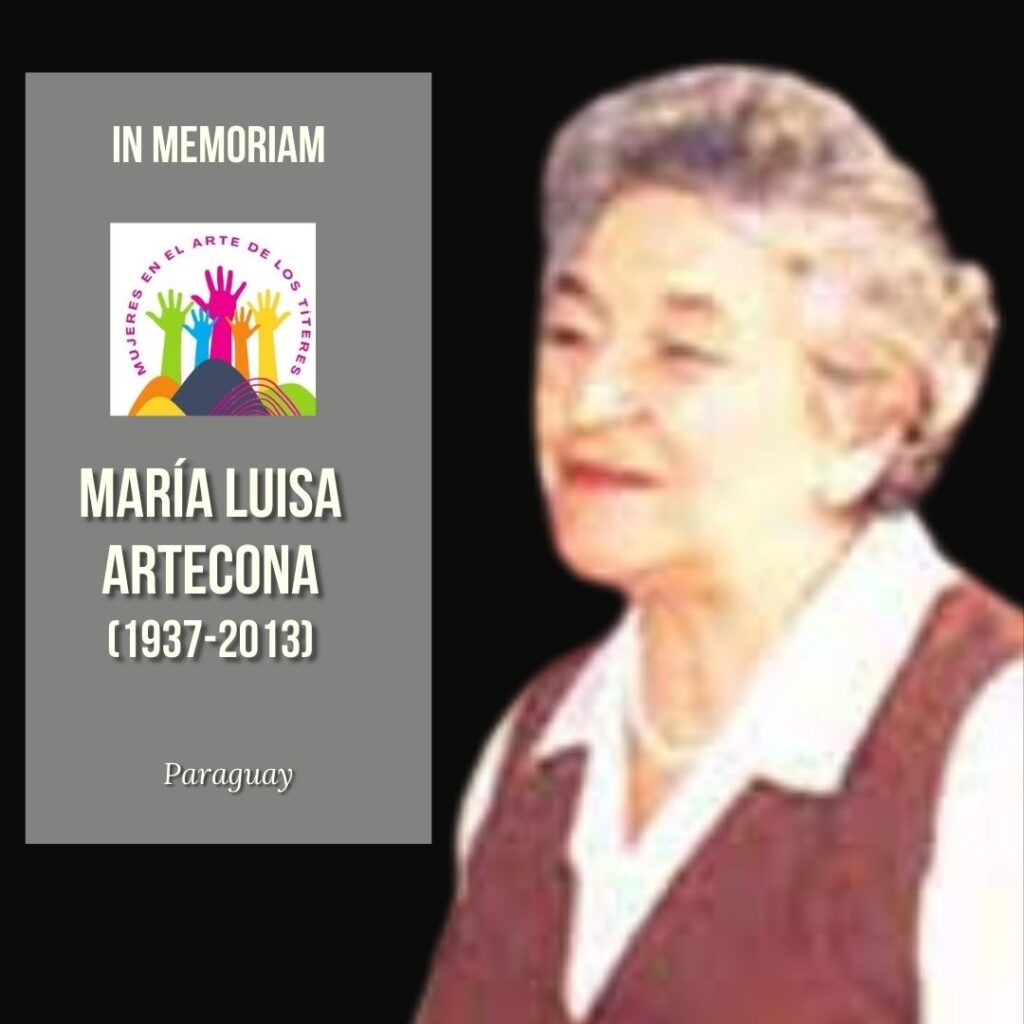Cora Baird, creadora/fundadora de American Puppet Arts Council, una organización sin fines de lucro dedicada a promover el arte de los títeres en Estados Unidos Investigación realizada por Elvia Mante para su proyecto «Mujeres en el arte de los títeres».
Cora Baird, creator/founder of the American Puppet Arts Council, a non-profit organization dedicated to promoting the art of puppetry in the United States.
Fue miembro del prestigioso Group Theatre, cuya lista incluía a Elia Kazan, Clifford Odets, Sanford Meisner y Morris Carnovsky. Y trabajó como actriz en varias películas Fundó el primer teatro de repertorio Actors Equity creado exclusivamente para títeres, y le puso el nombre de su marido. Y así también, nos borramos a nosotras mismas de la historia.
Actuó por última vez en Winnie the Pooh, en el teatro de títeres que ella misma fundó, en diciembre de 1967, una semana antes de su muerte por cáncer de pulmón.
Yo, Elvia Mante, me precio de ser una mujer interesada en las otras mujeres y en el arte de los títeres. Admito públicamente que nunca escuché hablar de Cora Baird. De su marido si, Bil Baird. De hecho tengo su libro: The Art of the Puppet (1965), pero nunca vi, admito mi descuido, que eran Bil & Cora Baird Puppets, como aparecen en las páginas que los buscadores me proporcionaron cuando escribí su nombre buscando mas información. Bil & Cora Baird Puppets. Bil & Cora Baird Puppets. Bil & Cora Baird Puppets.
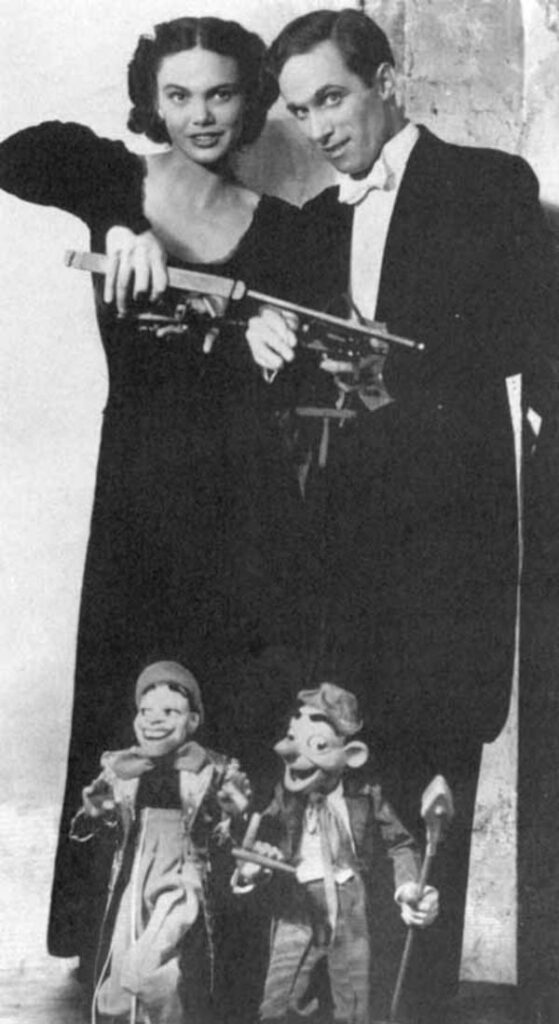
En todos lados aparecen sus nombres juntos y recalcan que todo lo hicieron juntos también: construyeron “juntos” sus propios títeres, escribieron “juntos” sus propios guiones y compusieron “juntos” la música para sus espectáculos (aunque creo que este último punto se refiere a que “juntos” mandaron hacer la música). Sus títeres (de ambos)aparecieron en programas de televisión y en obras de teatro y musicales de Broadway a principios de 1950. Incluso, “juntos” abrieron su propio teatro de marionetas, que ese si, a pesar de haberlo abierto “juntos”, en 1966 solo llevaba el nombre de él: “Bil Baird Theatre”.
Esta información la encontré en https://www.britannica.com/biography/Bil-and- Cora-Baird, y aunque, como pueden ver, la entrada está dedicada a ambos, luego se olvidan de ella para decir que el entrenó a titiriteros mas jóvenes, incluído Jim Henson y sus asociados.
Así que seguí buscando, en otras páginas información de Cora. Y la encontré en una que honra a mujeres judías, e incluso en esta, aunque se explayan un poco mas sobre Cora, si tienen la gentileza de nombrar a Bil. Comentario que hago porque si lo que se pone en el buscador es “Bil Baird” entonces si, solo hablan de el, como en la Enciclopedia Mundial de las marionetas, donde Cora aparece como partner y esposa, en una entrada dedicada a Bil Baird, pero ella no tiene su propia entrada.
Les comparto algunas cosas interesantes de ella:
Su nombre, fue Cora Eisenberg y nació el 26 de enero de 1912 en la ciudad de Nueva York de Morris y Anne (Burlar) Eisenberg.
Asistió a Hunter College, donde despertó su interés por el teatro. Después de la universidad, estudió danza con Martha Graham y fue aceptada como miembro del prestigioso Group Theatre, cuya lista incluía a Elia Kazan, Clifford Odets, Sanford Meisner y Morris Carnovsky (quien, treinta años después, narró la producción de Baird de L’Histoire del Soldat). Enseñó la técnica de danza Graham en el Toy Theatre y actuó en varias de sus producciones. Apareció en Broadway en Noah con Pierre Fresnay de la Comédie Française y con el Civic Repertory Theatre de Eva Le Gallienne.
En 1937, mientras trabajaba en una producción de Dr. Faustus dirigida por Orson Welles, Cora interpretó las voces de los siete pecados capitales. Fue durante esta producción que conoció a Bil Baird, quien había creado las marionetas de los pecados. Se casaron cuatro semanas después, el 13 de enero de 1937. Después de su matrimonio, ella decidió abandonar su carrera en el teatro «legítimo» y unirse a Bil en su compañía, donde se convirtió en socia de pleno derecho. La compañía se convirtió en Bil & Cora Baird Marionettes. “Mi propio patio trasero se volvió mucho más interesante que caminar por las calles durante once meses para conseguir un trabajo de dos semanas, así que cambié”. Según los amigos, después de su reunión, las marionetas femeninas de Bil comenzaron a parecerse cada vez más a Cora. Juntos tocaron en el circuito de vodevil, produjeron espectáculos para el Swift Pavillion en la Feria Mundial de 1939 y 1940, crearon y realizaron numerosos espectáculos industriales y formaron parte de la producción de Broadway de Ziegfeld Follies de 1941.
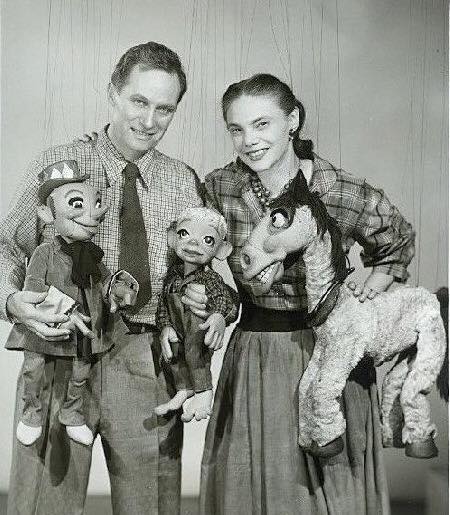
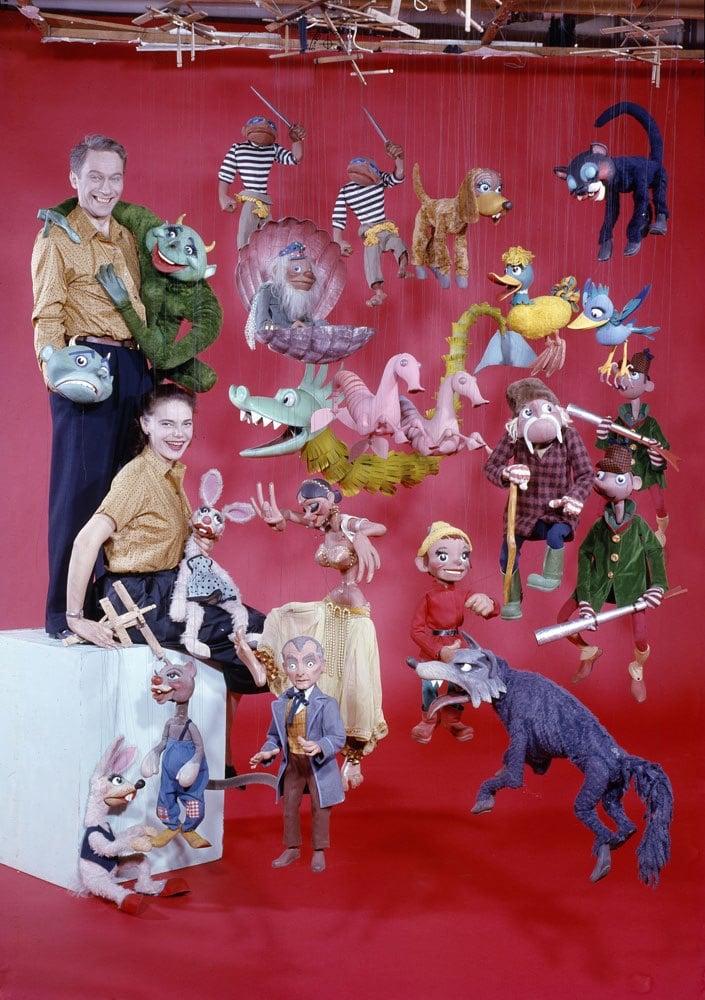
En 1965, los Baird hicieron realidad un sueño de mucho tiempo cuando abrieron el Teatro Bil Baird. Este fue el primer teatro de repertorio Actors Equity creado exclusivamente para títeres. El teatro funcionó continuamente durante once años bajo los auspicios del American Puppet Arts Council, una organización sin fines de lucro en la que Cora fue fundamental para crear, dedicada a promover el arte de los títeres en este país. Se montaron un total de veintiocho producciones y cerca de 240.000 niños y adultos conocieron el encantador mundo de los títeres.
Los Baird realizaron una gira por India, Afganistán y Nepal para la Agencia de Información de los Estados Unidos y una gira por Rusia para el programa de
Intercambio Cultural de los Estados Unidos, que fue uno de los primeros actos de ambos países al comenzar el final de la Guerra Fría. Cora se sintió inmensamente conmovida por la gente de estos países y las dificultades con las que vivían. En India, quedó atónita por el “espíritu de las personas que mantuvieron tanta dignidad frente a una pobreza tan increíble”. En Rusia, se conmovió hasta las lágrimas y se conmovió visiblemente cuando le mostraron “muy extraoficialmente” una sinagoga que había sido cerrada y tapiada. Ella estaba incrédula ante el concepto de «proscribir una fe».
Cora fue diagnosticada con cáncer de pulmón a mediados de la década de 1960. Durante la mayor parte de esos años, continuó actuando en los espectáculos presentados en el Teatro Bil Baird. Actuó por última vez en Winnie the Pooh, en diciembre de 1967, una semana antes de su muerte.
Si, todo lo hicieron juntos, como se menciona en tantas páginas.
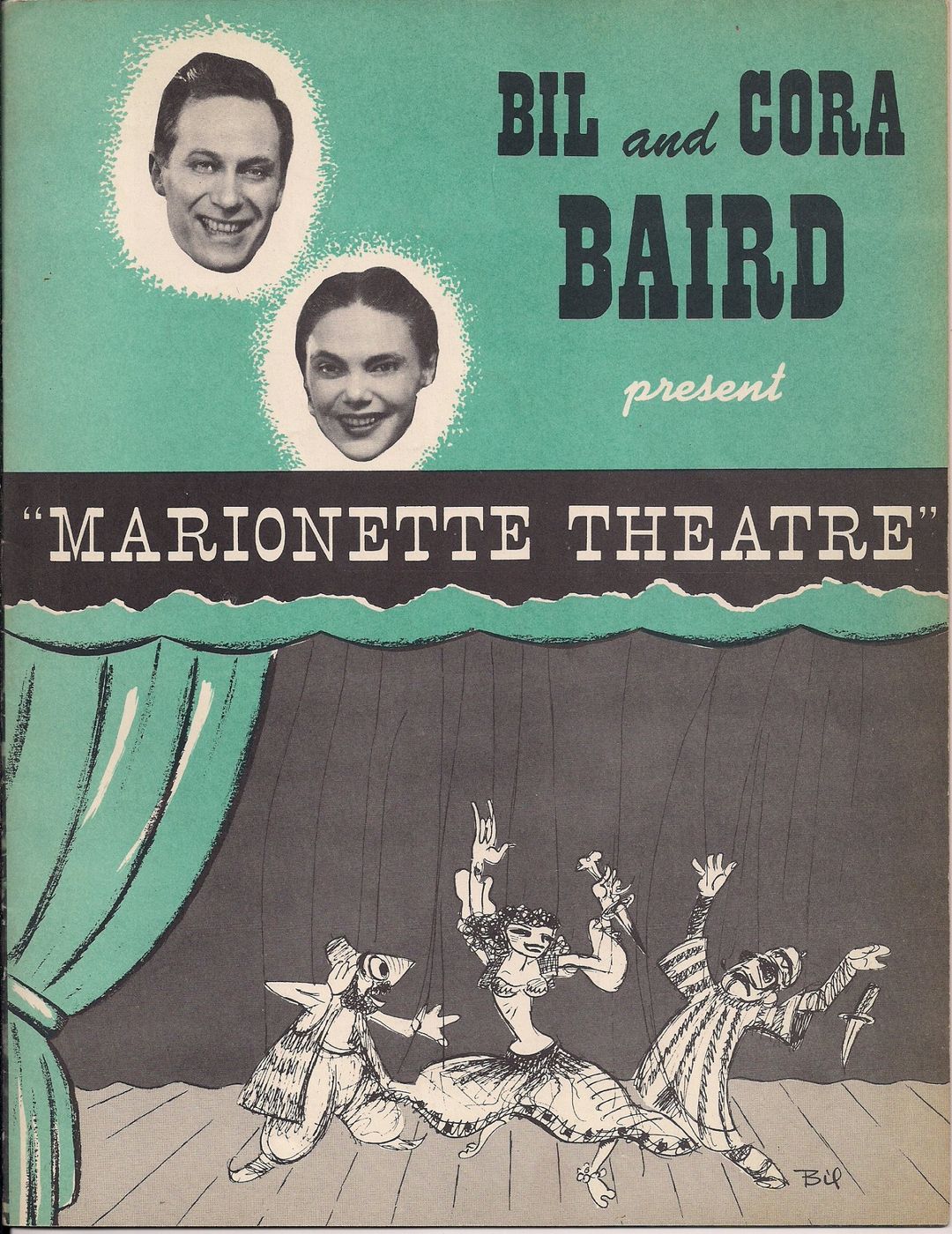
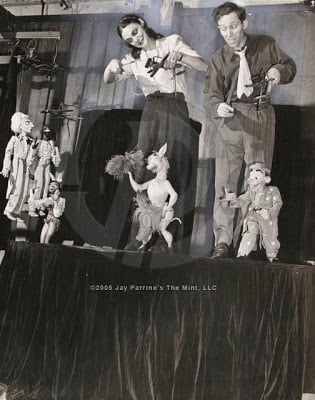
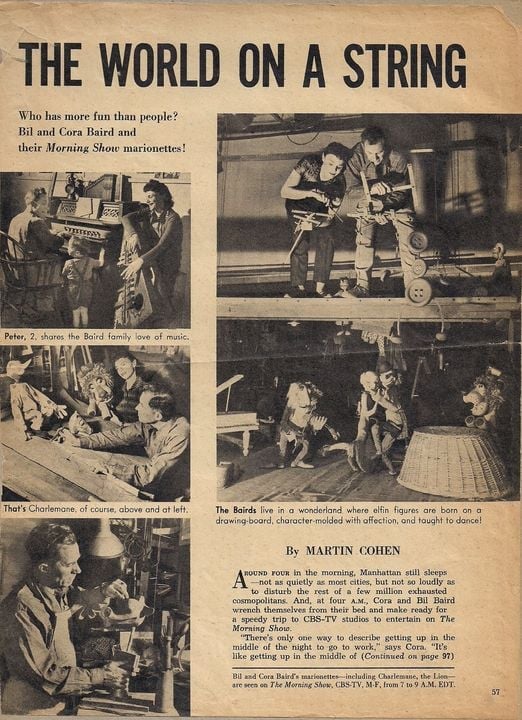
En la Enciclopedia Mundial dicen:
Bil y Cora Baird llevaron sus producciones de Ali Baba, Man in the Moon y Davy Jones Locker a los teatros de Broadway con música y letras de los principales talentos de Broadway. Baird (aquí solo lo nombran el apellido, así que debieron ser los dos ¿no?) creó más de 3000 títeres e hizo (¿hicieron?) más de 400 comerciales. En 1947, los Baird realizaron Aventuras en Telezonia para la compañía telefónica. Las producciones televisivas incluyen Life with Snarky Parker (1950), Whistling Wizard (1953), Babes in Toyland (1954), Peter and The Wolf with Art Carney (1958) y muchas apariciones especiales, como The Ed Sullivan Show y Jack Paar Show. De 1966 a 1971, Baird (¿sólo o ambos?) creó marionetas para mostrar a las audiencias de televisión cómo se movían los astronautas en el espacio. En 1962, el Departamento de Estado de EE. UU. envió a las marionetas de Bil Baird (¿Por qué no la mencionan a ella?) a una gira de 17 semanas por India, Nepal y Afganistán.
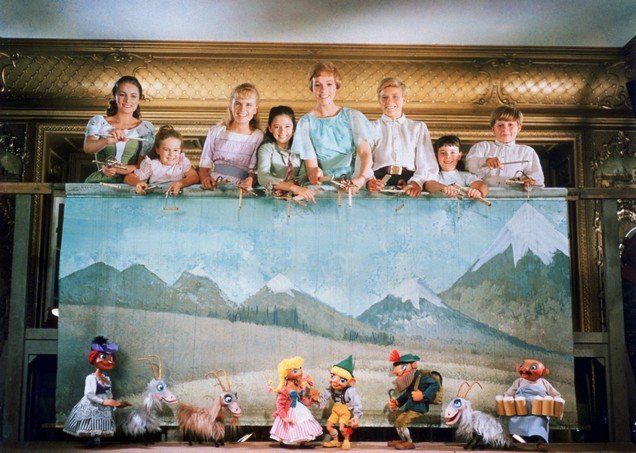
Los Baird viajaron a Rusia en 1963 como parte del intercambio cultural que trajo a Sergei Obraztsov a los Estados Unidos. En 1964, Marionettes de Bill Baird estuvo en la Feria Mundial de Nueva York. La película The Sound of Music ( La novicia rebelde) (Robert Wise, director, 1965) se estrenó con los Baird contribuyendo con el número «Lonely Goatherd». En 1967, una orquesta de Filadelfia encargó la producción de Baird de L’Histoire du Soldat de Igor Stravinsky. El trabajo fue revivido varias veces en la década de 1980 con la asistencia de Bob Brown, Penny Jones, Pady Blackwood y el hijo de los Baird, Peter Baird (1952-2004). Jerry Nelson, Leslee Asch, Marty Robinson, todos trabajaron para Bil Baird ( ¿y para ella no? ¿No quedamos en que todo lo hacían juntos?) antes de trabajar para Jim Henson.
En 1967, Bil Baird ( Juntos, lo abrieron juntos aunque solo ostentaba el nombre de él, ingratitudes de la vida, digo yo) abrió un teatro de 193 asientos, el Bil Baird Marionette Theatre, en 59 Barrow Street en la ciudad de Nueva York. Franz Fazarkas, Carl Harms y Frank Sullivan estaban en la empresa. El teatro funcionó durante once años, cerrando en 1978.
Bil Baird (junto a Cora Eisenberg, después conocida como Cora Baird) tuvo una de las carreras más deslumbrantes de los títeres estadounidenses. Los títeres de Baird (de ambos) se reconocen fácilmente como esculturas distintivas, modernistas y expresivas. Sus espectáculos y sus diseños fueron pulidos, pero siempre con una calidad lúdica y despreocupada que complació a una audiencia enorme y diversa. El trabajo televisivo de (los) Baird inspiró a muchos titiriteros jóvenes a comenzar a construir y actuar. Es el autor del libro profusamente ilustrado, The Art of the Puppet (1965).
Translation by google
She was a member of the prestigious Group Theatre, whose roster included Elia Kazan, Clifford Odets, Sanford Meisner and Morris Carnovsky. And she worked as an actress in several films. She founded the first Actors Equity repertory theater created exclusively for puppets, and named it after her husband. And so too, we erase ourselves from history.
She last performed in Winnie the Pooh, at the puppet theater she founded, in December 1967, a week before her death from lung cancer.
I, Elvia Mante, pride myself on being a woman interested in other women and in the art of puppetry, I publicly admit that I have never heard of Cora Baird. Of her husband yes, Bil Baird. In fact I have his book: The Art of the Puppet (1965), but I never saw, I admit my carelessness, that they were Bil & Cora Baird Puppets, as they appear on the pages that the search engines provided me when I wrote her name searching more information. Bil & Cora Baird Puppets. Bil & Cora Baird Puppets. Bil & Cora Baird Puppets.
Everywhere their names appear together and they emphasize that they did everything together as well: they built their own puppets “together,” wrote their own scripts “together,” and composed the music for their shows “together” (although I think this last point refers to because “together” they ordered the music to be made). Their puppets (both of them) appeared on television shows and in Broadway plays and musicals in the early 1950s. They even opened their own puppet theater “together,” which, despite having opened it “together,” in 1966 it only had his name: “Bil Baird Theatre”.
I found this information at https://www.britannica.com/biography/Bil-and-Cora-Baird, and although, as you can see, the entry is dedicated to both, they later forget about it to say that he trained younger puppeteers, including Jim Henson and his associates.
So I continued searching on other pages for information about Cora. And I found it in one that honors Jewish women, and even in this one, although they expand a little more on Cora, if you would be so kind as to name Bil. I comment because if what is put in the search engine is “Bil Baird” then yes, they only talk about him, like in the World Encyclopedia of Puppetry, where Cora appears as a partner and wife, in an entry dedicated to Bil Baird, but she doesn’t have her own entrance.
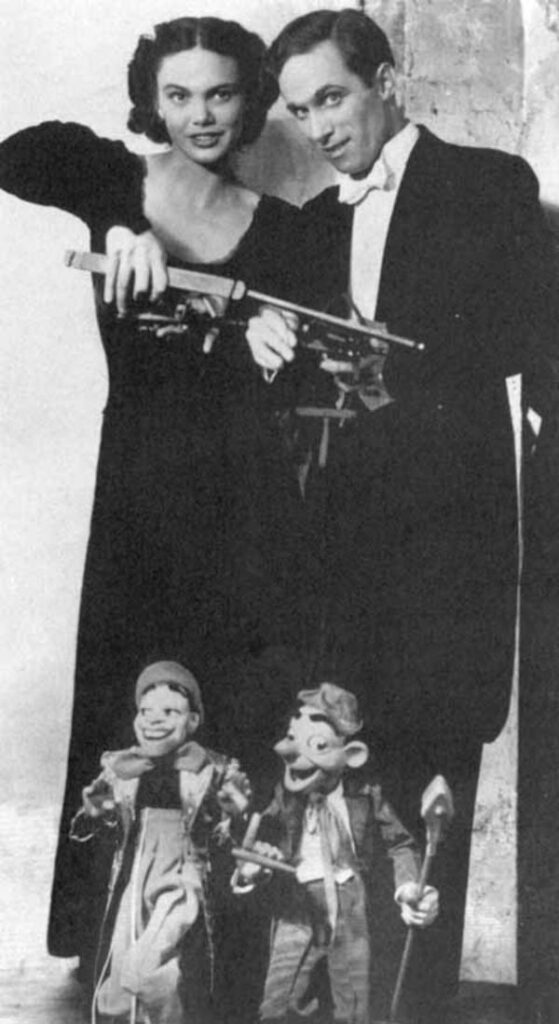
�

I share some interesting things about her:
Her name was Cora Eisenberg and she was born on January 26, 1912 in New York City to Morris and Anne (Mock) Eisenberg.
She attended Hunter College, where she sparked her interest in theater. After college, she studied dance with Martha Graham and was accepted as a member of the prestigious Group Theater, whose roster included Elia Kazan, Clifford Odets, Sanford Meisner, and Morris Carnovsky (who, thirty years later, narrated Baird’s production of L’ Histoire del Soldat). She taught Graham dance technique at the Toy Theater and performed in several of its productions. She appeared on Broadway in Noah with the Comédie Française’s Pierre Fresnay and with Eva Le Gallienne’s Civic Repertory Theatre.
In 1937, while working on a production of Dr. Faustus directed by Orson Welles, Cora performed the voices of the Seven Deadly Sins. It was during this production that she met Bil Baird, who had created the Sins Puppets. They married four weeks later, on January 13, 1937. After her marriage, she decided to abandon her career in «legitimate» theater and join Bil in her company, where she became a partner in void. The company became Bil & Cora Baird Marionettes. “My own backyard became a lot more interesting than walking the streets for eleven months to get a two-week job, so I changed.” According to friends, after their meeting, Bil’s female puppets began to look more and more like Cora. Together they played on the vaudeville circuit, produced shows for the Swift Pavillion at the 1939 and 1940 World’s Fair, created and performed numerous industrial shows, and were part of the 1941 Broadway production of the Ziegfeld Follies.
In 1965, the Bairds made a long-time dream come true when they opened the Bil Baird Theater. This was the first Actors Equity repertory theater created exclusively for puppets. The theater operated continuously for eleven years under the auspices of the American Puppet Arts Council, a nonprofit organization that Cora was instrumental in creating, dedicated to promoting the art of puppetry in this country. A total of twenty-eight productions were put on and nearly 240,000 children and adults learned about the charming world of puppets.
The Bairds toured India, Afghanistan and Nepal for the United States Information Agency and toured Russia for the Cultural Exchange of the United States, which was one of the first acts of both countries at the beginning of the end of the Cold War. Cora was immensely moved by the people of these countries and the hardships they lived with. In India, she was stunned by the “spirit of the people who maintained such dignity in the face of such incredible poverty.” In Russia, she was moved to tears and visibly moved when she was “very unofficially” shown a synagogue that had been closed and boarded up. She was incredulous at the concept of «outlawing a faith.»
Cora was diagnosed with lung cancer in the mid-1960s. For most of those years, she continued to perform in shows presented at the Bil Baird Theater. She last performed in Winnie the Pooh, in December 1967, a week before her death.

Yes, they did everything together, as mentioned in so many pages.

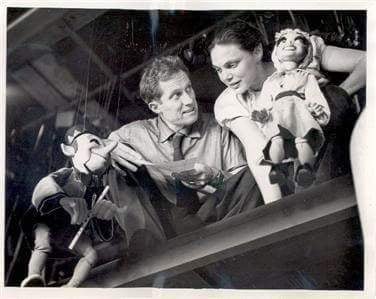
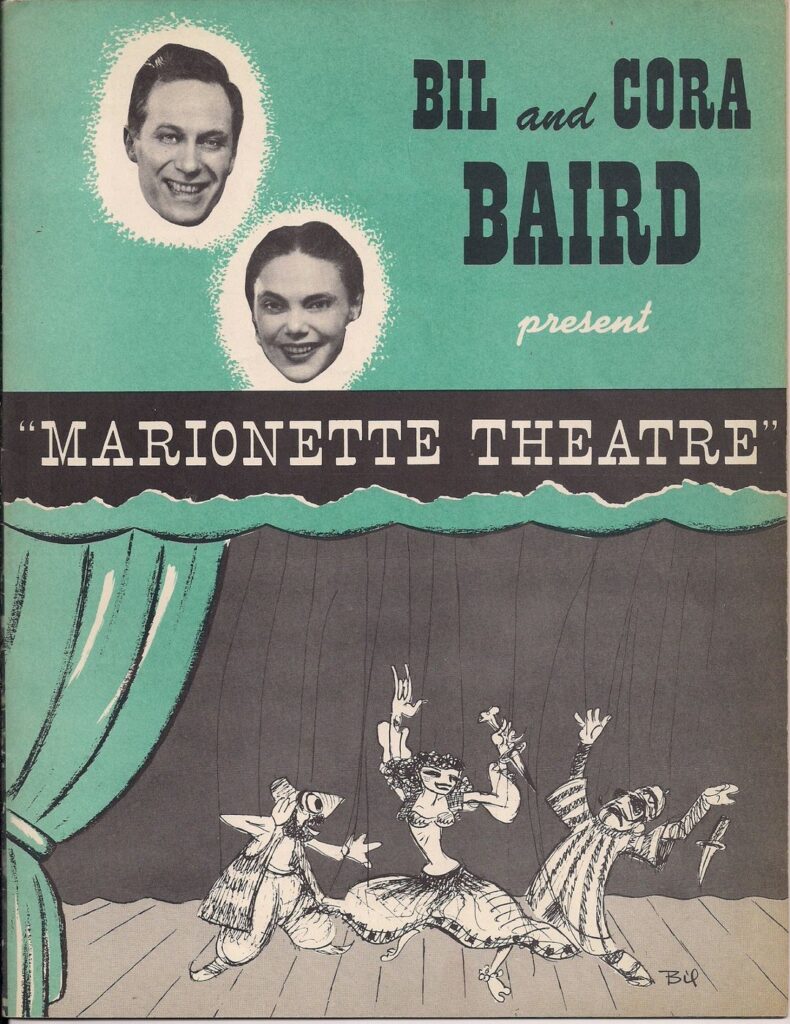
In the World Encyclopedia they say:
Bil and Cora Baird brought their productions of Ali Baba, Man in the Moon, and Davy Jones Locker to Broadway theaters with music and lyrics from top Broadway talent. Baird (they only give him his last name here, so it must have been both of them, right?) created more than 3,000 puppets and made (they made?) more than 400 commercials. In 1947, the Bairds made Adventures in Telezonia for the telephone company. Television productions include Life with Snarky Parker (1950), Whistling Wizard (1953), Babes in Toyland (1954), Peter and The Wolf with Art Carney (1958) and many guest appearances, including The Ed Sullivan Show and the Jack Paar Show. From 1966 to 1971,
Baird (alone or both?) created puppets to show television audiences how astronauts moved in space. In 1962, the US State Department sent the Bil Baird Puppets (Why don’t they mention her?) on a 17-week tour of India, Nepal and Afghanistan.

The Bairds traveled to Russia in 1963 as part of the cultural exchange that brought Sergei Obraztsov to the United States. In 1964, Bill Baird’s Marionettes was at the New York World’s Fair. The film The Sound of Music (Robert Wise, director, 1965) was released with the Bairds contributing the number «Lonely Goatherd.» In 1967, a Philadelphia orchestra commissioned Baird’s production of Igor Stravinsky’s L’Histoire du Soldat. The work was revived several times in the 1980s with the assistance of Bob Brown, Penny Jones, Pady Blackwood and the Bairds’ son Peter Baird (1952-2004). Jerry Nelson, Leslee Asch, Marty Robinson, all worked for Bil Baird (and not her? Didn’t we agree that they did everything together?) before working for Jim Henson.
In 1967, Bil Baird (Together, they opened it together although it only bore his name, ingratitudes of life, I say) opened a 193-seat theater, the Bil Baird Marionette Theatre, at 59 Barrow Street in New York City . Franz Fazarkas, Carl Harms and Frank Sullivan were in the company. The theater operated for eleven years, closing in 1978.
Bil Baird (along with Cora Eisenberg, later known as Cora Baird) had one of the most dazzling careers of American puppetry. Baird’s puppets (both of them) are easily recognized as distinctive, modernist and expressive sculptures. His shows and designs were polished, but always with a playful, carefree quality that pleased a huge and diverse audience. The Bairds’ television work inspired many young puppeteers to begin building and performing. He is the author of the lavishly illustrated book, The Art of the Puppet (1965).

